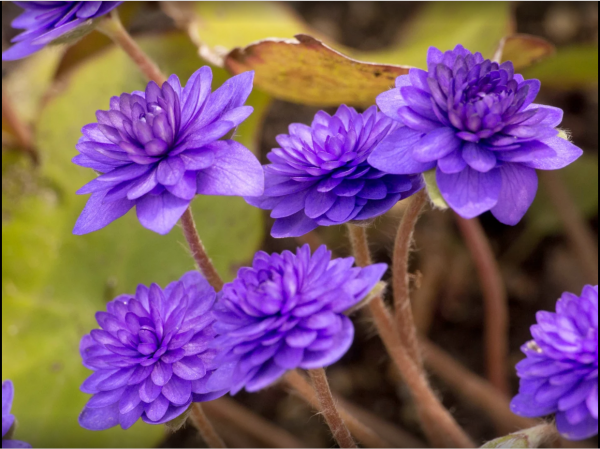The Diverse Anemone Hepatica Findings in LVM Forests
This May, transition to summer in nature is gradual and slow, giving us numerous opportunities to enjoy the so-called spring plants for a longer period of time. One of the plants characteristic of Latvia is the common hepatica or Hepatica nobilis Mill. After the bright flowering in spring, only the well-visible leaves testify to the presence of the plant in summer. Common hepatica blossom is beautiful and decorative.
Photo: Common hepatica – purple, found in Vidzeme, in a forest between Zaube and Katrīna in 2017 (Vija Kreile)
Taking a closer look at the small plant, you can also find atypical blossoms in different colours, mostly white, blue and various shades of purple, which is characteristic of spring plants containing a large amount of anthocyanins (one of the four groups of plant pigments). Anthocyanins determine the colour of the common hepatica; the colour of anthocyanin crystals is directly related to the environment in which they are to be found. For example, in an acidic environment, anthocyanins acquire a saturated red colour. Alkaline environment turns the crystals blue. In a neutral environment, crystals acquire a purple colour. Therefore, depending on the environmental conditions and the genetic composition of the plant, different shades of common hepatica can be found in the nature.
“Stuffed” common hepatica
Photo: In the spring of 2019 and 2020, a wild clone of the common hepatica was found in forests around Lake Juvers (Ieva Rove)
When taking a walk in a forest, there is a slight chance to find the rare “stuffed” common hepatica, which are made up of different clones of wild common hepatica. The majority of clones are exquisitely beautiful.
In such natural conditions, the gradual formation of new subspecies and species takes place, nature finds different solutions for the survival of the species; over the time, the most suitable specimens learn to survive in the respective environment. It is not uncommon to spot the gorgeous “mistakes or attempts”. These are specimens of the plant that are not naturally able to reproduce.
Photo: In the spring of 2020, a vital wild clone of the common hepatica was found in the vicinity of Uguņi in Vandzene Rural Territory (Ieva Kukle-Ozoliņa)
Considering that the common hepatica is widespread in Latvia throughout the country, found on sunny slopes, in deciduous forests, shrubs and ancient parks, it is possible to spot wild clones and plants with atypical colouring almost throughout the entire the territory of Latvia. This spring, the LVM planner, who can also be proud of the discovery of a mushroom that had never been seen before in Latvia, observed an unusual wild clone of the common hepatica in Vandzene Rural Territory.
Breeders are also engaged
Photo: Common hepatica variety “Ciecere” (Juris Egle)
Breeders, both in Latvia and in the world, purposefully search for, collect and propagate particular wild clones of common hepatica. Some clones have already been developed as common hepatica varieties and are available as an ornamental plant. Breeder Juris Egle has selected a significant number of wild clones and propagated them, maintaining at least 299 common hepatica clones in his collection. The common hepatica clone “Ciecere” has been propagated and distributed in gardens and collections also outside Latvia. It stems from a wild clone collected near Lake Ciecere in 2012.
The Latvian breeding virtual hall of fame includes three varieties of common hepatica created by breeder Juris Egle: “Ciecere”, “Vārtāja” and “Ālande”, all of them come from a wild clone found in Kurzeme (https://www.nbd.gov.lv/lv/slavas-zale/gints/20).
Common hepatica and their varieties are a popular ornamental plant throughout Europe, with their rich collections in a variety of colours, including stuffed flowers. The Japanese are the world leaders in the selection of the common hepatica; the varieties they create are very beautiful: with white, blue, red, pink, multi-coloured, stuffed or partially stuffed blossoms.
LVM environmental experts remind that the common hepatica belongs to the buttercup family, which means that they are poisonous!







